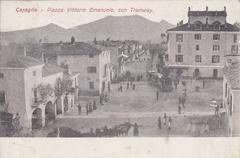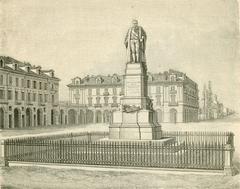
Cathedral of St Mary Cuneo: Visiting Hours, Tickets, and Historical Significance
Date: 04/07/2025
Introduction
Nestled in the historic heart of Cuneo, Italy, the Cathedral of St. Mary—also known as Cattedrale di Santa Maria del Bosco or the Cathedral of St. Mary and St. Michael the Archangel—stands as a magnificent testament to centuries of religious devotion, architectural evolution, and cultural significance. This remarkable edifice not only serves as the spiritual heart of the city, but also as a vibrant symbol of Cuneo’s identity, reflecting its medieval origins, Baroque transformation, and ongoing role in community life. Visitors are drawn by its stunning blend of architectural styles—ranging from Gothic and Renaissance influences to Baroque artistry—showcased in features such as the polychrome marble high altar, intricate frescoes, and the imposing 17th-century bell tower.
Founded during Cuneo’s formative years in the late 12th and early 13th centuries, the cathedral is dedicated to the Virgin Mary under the title “Santa Maria del Bosco” (Saint Mary of the Woods) and to St. Michael the Archangel, both emblematic of protection and faith. Over the centuries, significant reconstructions, including Baroque renovations in the 17th century and Neoclassical enhancements in the 19th century, have shaped its harmonious, multifaceted appearance (Italien Entdecken, Museo Diffuso Cuneese).
Whether you aim to explore Cuneo’s rich heritage, seek spiritual reflection, or simply admire architectural beauty, this comprehensive guide provides essential details on visiting hours, ticketing, accessibility, nearby attractions, and practical tips. The cathedral’s integration into the city’s urban fabric—close to Piazza Galimberti, Via Roma, and the Bishop’s Palace—makes it a central and accessible highlight for any visitor (WildTrips, Visit Cuneese).
Table of Contents
- Introduction
- Historical Roots and Evolution
- Architectural Highlights
- Civic and Religious Role
- Visiting Information
- Community and Cultural Life
- Nearby Attractions
- Preservation and Modern Relevance
- FAQ
- Plan Your Visit
Historical Roots and Evolution
The Cathedral of St. Mary and St. Michael traces its origins to 1198, the year Cuneo itself was founded on a strategic plateau between the Stura and Gesso rivers (italien-entdecken.de). The cathedral was established as a focal point of the new settlement, symbolizing the intertwined destinies of city and church. Early on, it was dedicated to Santa Maria del Bosco, honoring the Virgin Mary, and to St. Michael the Archangel, guardian figures resonant with Cuneo’s defensive spirit (gcatholic.org).
The original church was a modest Benedictine priory in a wooded area, evolving into a parish center as Cuneo grew. Over centuries, noble families and guilds endowed altars and chapels, embedding the cathedral deeply into the city’s social and spiritual life (Museo Diffuso Cuneese). A dramatic event—the collapse of the vault in 1656—prompted a Baroque reconstruction, while the elevation of Cuneo to a bishopric in 1817 marked the church’s transformation into a diocesan cathedral (Insieme Piemonte).
Architectural Highlights
Façade and Bell Tower
The cathedral’s neoclassical façade, completed in the 19th century by Antonio Bono, features a welcoming portico with Corinthian columns and a triangular pediment, symbolizing openness to the city (Live the World). The impressive bell tower, rebuilt in the 17th century, rises above Cuneo’s skyline, serving both practical and symbolic purposes.
Interior Layout and Artistic Elements
Inside, the cathedral follows a Latin cross plan with a spacious nave, side chapels, and a luminous dome. The interior is richly adorned with frescoes, many by Giuseppe Toselli, depicting the Assumption of the Virgin Mary surrounded by Cuneo’s patron saints (Museo Diffuso Cuneese). The marble high altar, designed by Andrea Pozzo, exemplifies Baroque exuberance, while intricately carved choir stalls and side chapels display the craftsmanship of local artists.
Side chapels, dedicated to various saints, are decorated with unique artworks, including sculptures by Giovanni Cini and Antonio Gagini. These chapels not only offer intimate spaces for devotion but also serve as a gallery of regional religious art (wildtrips.net).
Dome and Frescoes
The dome, painted in 1834, is a major highlight, bathing the interior in natural light and offering visitors a celestial vision of Marian devotion. The vibrancy of the frescoes, enhanced by careful restoration, creates a spiritual and aesthetic focal point.
Civic and Religious Role
The cathedral has long been central to Cuneo’s civic and religious life. Positioned near Piazza Galimberti and the Bishop’s Palace, it has witnessed and sheltered the city through wars, sieges, and celebrations (audiala.com). Its bells have rallied citizens in times of crisis, while its chapels have hosted generations of family milestones. As the seat of the Diocese of Cuneo–Fossano since 1817, the cathedral remains the primary site for major liturgical celebrations, including ordinations and feast days (gcatholic.org).
Visiting Information
Hours and Admission
-
Standard visiting hours:
- Monday to Saturday: 8:00 AM – 12:00 PM; 3:00 PM – 7:00 PM
- Sunday and holidays: 8:00 AM – 12:30 PM; 3:30 PM – 7:30 PM
- Note: Hours may vary seasonally or during special events; check locally for updates.
-
Admission:
- Entrance is free for individual visitors; donations are appreciated for preservation (Visit Cuneese).
Tickets and Guided Tours
- Guided Tours:
- Available during special events and by arrangement with local agencies.
- Private group tours can be booked, starting from approximately €150 (Meet Piemonte).
- Interpretive materials are provided in multiple languages.
Accessibility
- Wheelchair access is available via ramps at the main entrance and throughout key areas.
- Visitors with mobility challenges are encouraged to inquire about alternative access points or assistance (Meet Piemonte).
Photography Tips
- Non-flash photography is permitted; tripods are discouraged.
- Best light for exterior photos is during the golden hour.
- Respect the atmosphere, especially during services.
Community and Cultural Life
The cathedral continues to play a dynamic role in Cuneo’s community, hosting religious festivals, concerts, and cultural events throughout the year. Its acoustics make it an exceptional venue for choral and orchestral performances. During local festivals and citywide events, the cathedral often serves as the backdrop for processions and public ceremonies, reinforcing its significance as both a spiritual and civic landmark (Italia Absolutely).
Nearby Attractions
The cathedral’s central location allows visitors to easily explore other Cuneo highlights:
- Piazza Galimberti: Grand square with arcades, shops, and vibrant local life.
- Via Roma: Historic thoroughfare lined with porticoed buildings and boutiques.
- Bishop’s Palace (Palazzo Tornaforte): Adjacent to the cathedral.
- Church of San Francesco & Civic Museum: Notable sites for art and history (Museo Diffuso Cuneese).
Preservation and Modern Relevance
Ongoing restoration initiatives, supported by local authorities and heritage organizations, ensure that the cathedral’s architectural and artistic treasures are preserved for future generations (Piemonte Italia). Sensitive integration of modern amenities—such as climate control and improved lighting—enhances both preservation and visitor comfort.
Frequently Asked Questions (FAQ)
Q: What are the cathedral’s visiting hours?
A: Monday–Saturday: 8:00 AM–12:00 PM & 3:00 PM–7:00 PM; Sunday/holidays: 8:00 AM–12:30 PM & 3:30 PM–7:30 PM. Hours may vary; check locally.
Q: Is there an entrance fee?
A: No, entry is free. Donations support preservation.
Q: Are guided tours available?
A: Yes, during special events or by arrangement with local guides.
Q: Is the cathedral accessible for visitors with disabilities?
A: Yes, ramps and modified entrances are available.
Q: Can I take photographs inside?
A: Yes, non-flash photography is allowed.
Q: What are some nearby attractions?
A: Piazza Galimberti, Via Roma, the Bishop’s Palace, and the Church of San Francesco.
Plan Your Visit
To enjoy the best of the Cathedral of St. Mary, visit during spring or autumn for ideal lighting and mild weather. Combining your cathedral tour with a walk through Cuneo’s historic center, visits to local markets, and sampling Piedmontese cuisine will provide a rich cultural experience.
For the latest updates on visiting hours, special events, and guided tours, consult the official Cuneo tourism website or download the Audiala app for curated itineraries and insider tips.
Summary and Final Recommendations
The Cathedral of St. Mary in Cuneo is a beacon of architectural beauty, historical richness, and spiritual vitality. Its layered history—from medieval foundation through Baroque transformation to modern-day relevance—makes it a must-see for art lovers, pilgrims, and cultural travelers. Free access, central location, and proximity to key city landmarks ensure a convenient and enriching visit. To deepen your experience, consider a guided tour, time your visit with local festivals, and explore the surrounding historic center.
Embark on your journey to discover this architectural and spiritual jewel at the heart of Cuneo (Italien Entdecken, Museo Diffuso Cuneese, WildTrips).
References
- Italien Entdecken - Cathedral of St. Mary and St. Michael in Cuneo: Hours, Tickets, and History
- WildTrips - Cathedral of St. Mary in Cuneo: Visiting Hours, Tickets, and Architectural Highlights
- Museo Diffuso Cuneese - Cathedral of St. Mary of the Woods in Cuneo: Hours, Tickets, and Historical Highlights
- Meet Piemonte - Cathedral of St. Mary of the Assumption in Cuneo: Hours, Tickets, and Historical Highlights
- Visit Cuneese - Cuneo City and Cathedral Overview



